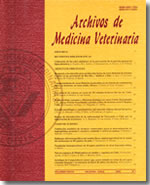Distribution and persistence of three strains infectious bronchitis virus (VBI) in tissues of specific pathogen free chicks
Main Article Content
Abstract
The distribution and persistence of three field strains of the IB virus (Austral 3, 5 and 14), on experimentally inoculated SPF chicken was studied. In order to determine its distribution, three groups of 30 chicks that were each two-weeks old, were inoculated by ocular and nasal instillation with 104 EID 50/0.1 ml of each strain. Three chicks of each group were slaughtered before and after the infection (every 8 hours until the second day post infection and every 12 hours until the fourth day), collecting samples of trachea, lung, proventriculus, gall bladder, small intestine, large intestine, kidney, thymus and Fabricius bursa. On every sampling, tissues of the same kind were grouped and homogenized, later, PBS with antibiotic was added in a 5% weight/volume relationship. The recovery of the strains were performed on SPF embryonated eggs and tracheal rings, and their results were expressed as isolation index.
The study of persistence of the virus in tissues was performed in three groups of 21 chicks that were each two-weeks old. Every group was infected with 105 EID 50/0.1 ml of viral suspension through ocular, nasal and tracheal instillation on days 7, 12, 19, 26, 33, 40 and 47. After the inoculation tracheal, lung, proventriculus, small intestine, large intestine and kidneys samples were collected, and its isolation on embryonated eggs and tracheal rings was initiated.
On the first trial, the strains were recovered from both biological substratum of the nine tissues examined throughout the whole experiment; although they were not recovered from 100% of the samples. The largest isolation indexes were obtained from the tracheal suspension, lung, proventriculus, kidney and large intestine. In some tissues the frecuency of isolations of the strains in the first passage was higher in the tracheal rings. There were no major differences in the persistence of the strains on the different tissues, only a longer permanence on the large intestine and kidneys was observed (19 and 47 days respectively).

